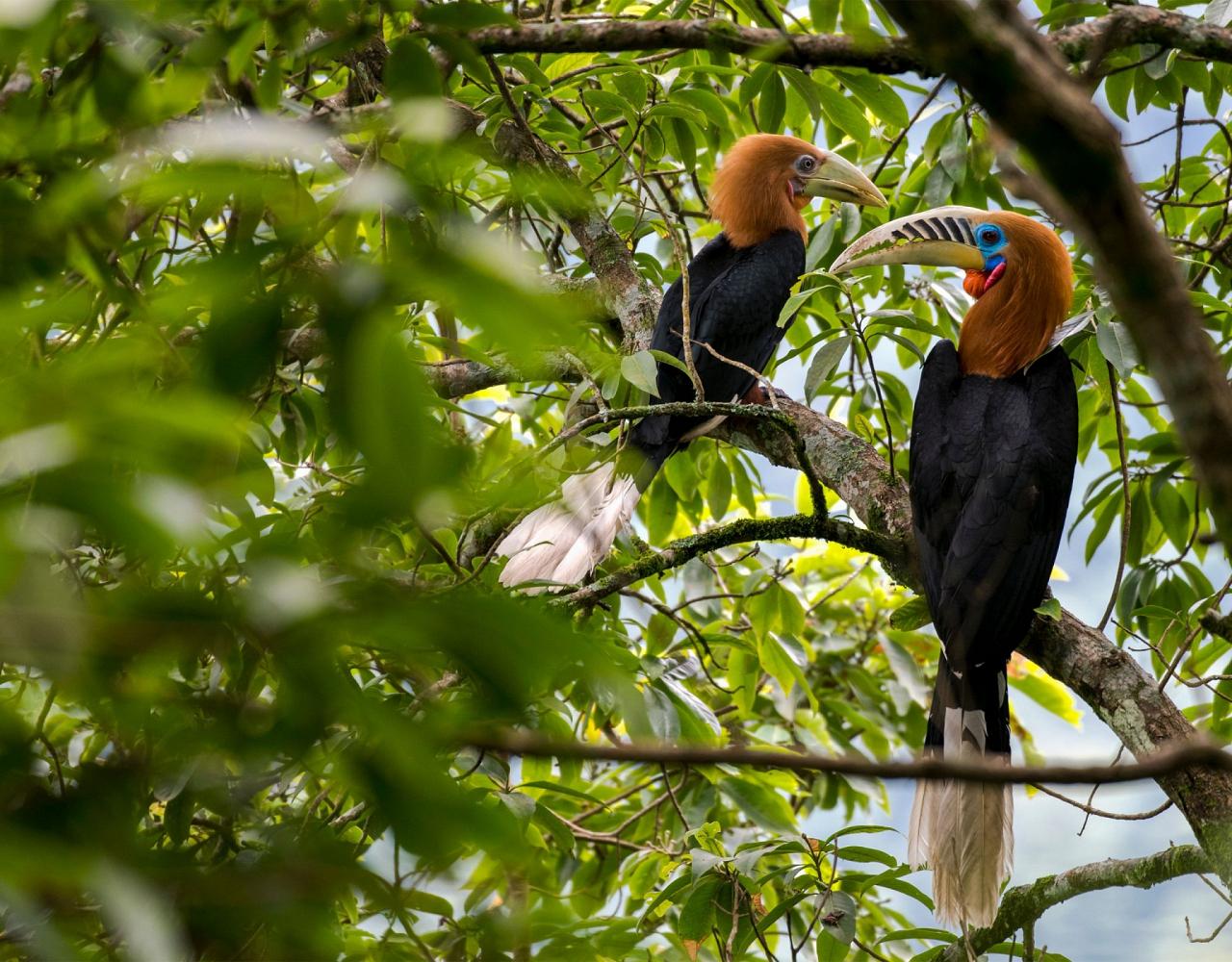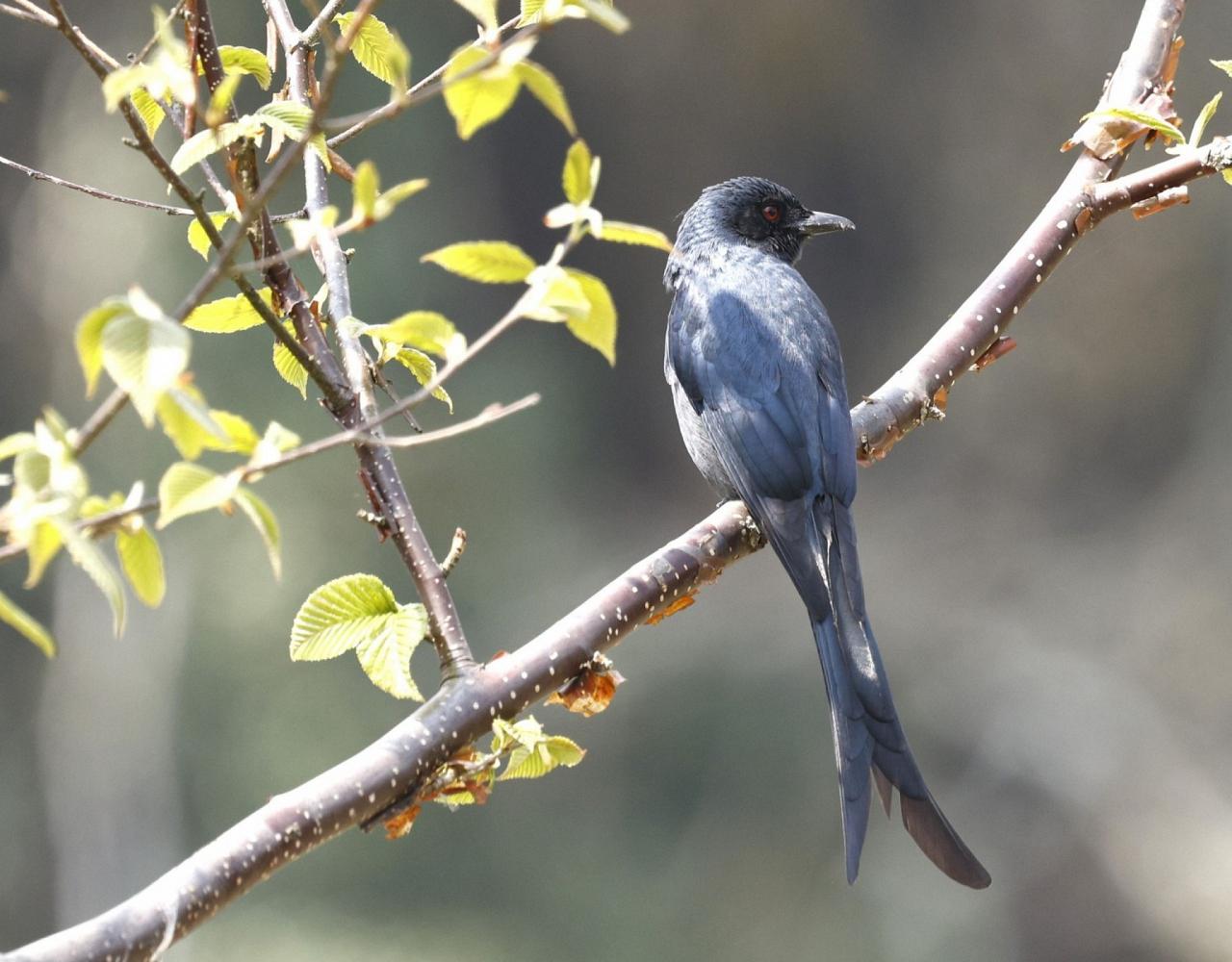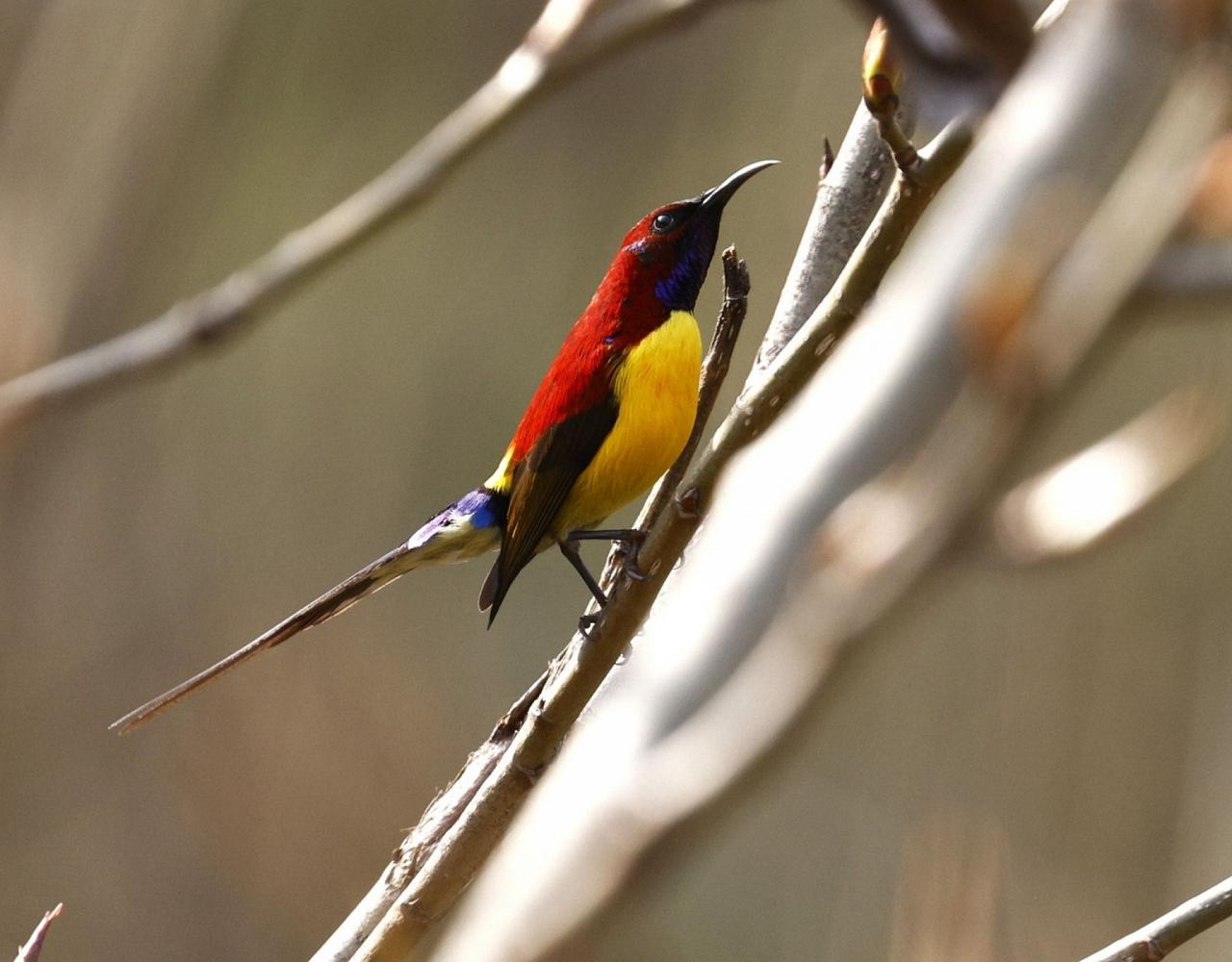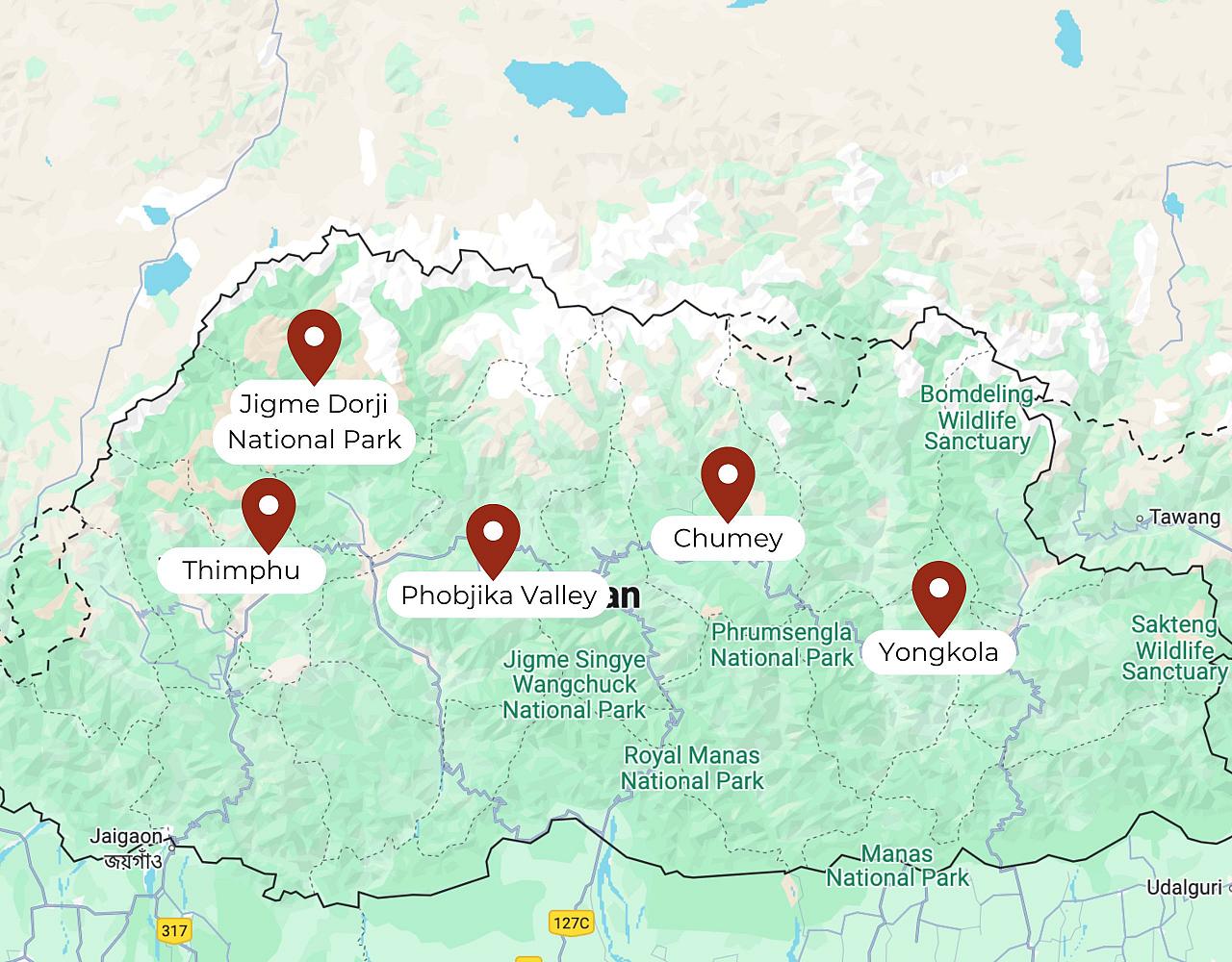- Overview
- Full Itinerary
- Extensions
- Photo Gallery
- Costing
- Travel Details
- Trip Reports
- Guide
- Map
- Know Before You Go
Over the past two years, our birding tour to the Kingdom of Bhutan has left us with so many lasting impressions. It is one of the most remarkable tours our founder, Peg Abbott, has experienced. In 2025 we are pleased to offer two departures, one in spring with the glory of the rhododendron bloom, and one in fall when the endangered Black-necked Cranes arrive to winter in the Phobjika Valley. We focus on prime areas for birding and scenic vistas at a pace you can absorb the wonders of the mountains — the Himalayan forests are intriguing and views abound!
Nestled between India and China, biodiverse Bhutan is home to seven percent of the world’s bird species. Roughly the size of Switzerland, it is naturally dramatic, rising from the lowland rainforest of the Indian-Malay subcontinent to Himalayan heights far above tree line, its mountains are interspersed with valleys carved by fast-moving rivers. Bhutan’s elevation ranges from 315 feet to a staggering 24,500 feet above sea level.
This peaceful Buddhist kingdom is also a conservation champion, with a quarter of its lands protected by national parks and a constitutional decree that no less than 60 percent of the country should be covered in forest. More than 70 percent of it is now richly forested, an important reason some 700 birds call Bhutan home. The incredibly scenic region we travel includes many of the largest and most distinctive birds in Asia, and many riotously colorful and charismatic ones as well, including hornbills, sunbirds, parrotbills, wren-babblers, and laughingthrush, to name just a few. We stay longer in the mountain areas on this trip, dropping down a bit into broadleaf forest valleys.
On this Bhutan tour, our visit is timed with an annual festival (mostly locals including school children) for the highly endangered Black-necked Cranes, which return each year to winter in the stunning Phobjika Valley. The valley protects their favorite marsh areas, and there is a visitor center for crane viewing with displays. The cranes are held sacred in Bhutanese culture and the experience of seeing them is very moving, both from a natural and cultural perspective. In addition to cranes, and other birds, there are striking mammals we hope to see too, including Giant Squirrel, the beautiful and endangered Golden Langur monkey, and even rarer Red Panda, seen twice on a mountain pass we crossed last year!
Our tour is also culturally rich, a glimpse of rural life hosted by wonderful guides that share their country’s story as well as their expertise with birds. We visit architecturally marvelous Buddhist fortress-monasteries, locally called “dzongs,” where we observe traditionally robed monks and their devotees. We stop at a weaving studio where you see weavers working and have some fun at one of Bhutan’s first brew pubs. Join us to learn why Bhutan is known as the “Land of the Thunder Dragon,” an emblem that adorns the national flag, expressing the mysticism that pervades this fascinating culture.
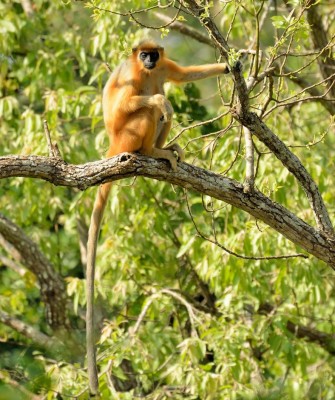
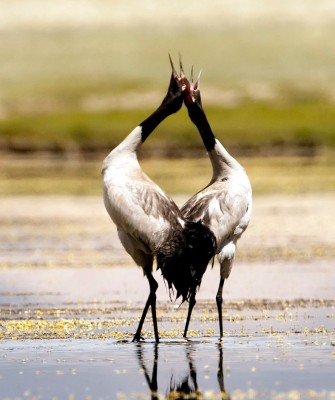

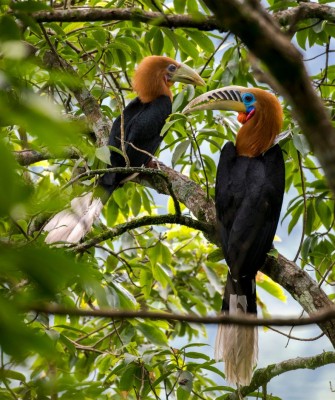
Tour Highlights
- Marvel at some of the most spectacular scenery anywhere in the world, including mountain peaks approaching 25,000 feet as a gorgeous backdrop to our birding. Fall is known for clear skies and the best chance to view high peaks all around.
- Experience a local festival to welcome back wintering endangered Black-necked Cranes, a meaningful experience mostly attended by local people.
- Enjoy tremendous diversity of birdlife thanks to our tour’s varied altitudes and habitats as we cross this Himalayan nation, ranging from lowland rainforest to mountain passes well above tree line at 13,000 feet. Special birds here include some of the world’s largest hornbills, a half dozen species of laughingthrush, charismatic wren-babblers and parrotbills, and many glorious sunbirds.
- Marvel at bird superstars, including technicolor Himalayan Monal, Satyr Tragopan, Rufous-necked Hornbill, Fire-tailed Myzornis, Ibisbill, Beautiful Nuthatch, and gorgeous Ward’s Trogon.
- Admire traditional architecture and visit Buddhist dzongs in this highly devout country. Prayer flags flapping in the breeze are ubiquitous in the settled (not really urban) areas we visit, imbuing our journey with a unique sense of place.
- Travel adventurously with us, birding the single road that crosses this sparsely populated country, thrilling at mixed flocks in its most productive habitats close to our nature lodges.
- NEW for 2025, we’ve added a day at a reliable site for observing White-bellied Heron in the wild, one of the most critically endangered bird in the world.
- Keep an eye on the skies for one of thirty raptors found in Bhutan, including Changeable Hawk Eagle, Crested Serpent Eagle, Himalayan Vulture, Steppe Eagle, Long-legged Buzzard, and Pallas’ Fish Eagle.


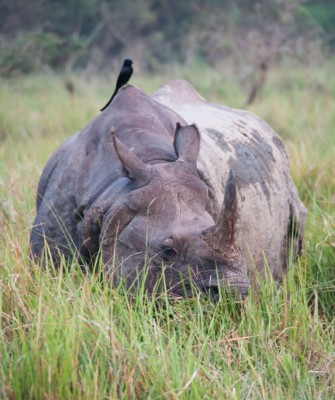

Trip Itinerary
Itineraries are guidelines; variations in itinerary may occur to account for weather, road conditions, closures, etc. and to maximize your experience.
Tues., Nov. 4 Early Arrivals
We strongly recommend that you arrive a day early; you have flown a very long way and we want you to be rested for this amazing journey.
If you are participating in the main tour only, you have two options for arriving early:
1. You can fly into and overnight in Delhi tonight; our operator will book your flight into Paro for tomorrow morning. You will join the extension group for this flight.
2. You can fly directly into and overnight in Paro near the airport; flights come direct from Bangkok or Delhi.
The cost of arriving early is not included in your tour cost but we can help you book your hotel and add it to your invoice. There are no formal activities today, but you will have your fellow travelers’ contact information, so it may be fun to get together for a casual meal this evening.
Wed., Nov. 5 Welcome to Bhutan! Paro | Thimphu
Paro is a lovely small city in one of Bhutan’s loveliest valleys rimmed by high peaks of the Himalayas. Its centerpiece is the Paro Chhu River and the impressive Rinpung (Paro) Dzong. One has the feel in Paro of ancient meeting modern, as trendy coffee shops and cafes have sprung up and you have a chance to see some of the region’s arts and crafts.
Typically the flights from Delhi or Bangkok are very early, to work with the mountain air currents and be safe. So you arrive in the morning and have this full day in Bhutan. The airport luggage carousel is a welcoming treat and a glimpse into how much this country supports art and artisans. The scenic drive to the capital city of Thimphu takes about an hour and a half and along the route you see classic Bhutanese architecture and some chortons and stupas, small spiritual sites. Along the river we check for Ibisbill, one of Bhutan’s iconic species. In Thimpu, we settle into our accommodations at a cool and comfortable 7000 feet. If there is interest, we can stop near Thimphu at the national weaving center where we can see artists at work and perhaps purchase a woven treasure.
At dinner we provide an overview of our journey and for those that wish, we start our nightly species checklist to tally what we find each day. Accommodations in Thimphu (B,L,D)
Thurs., Nov. 6 Thimphu | Tsirang — Home of the White-bellied Heron
Today we leave Thimphu and head up Dochu La Pass. At the Royal Botanical Garden, we walk a loop trail among wild strawberries, violets, gentians, rhododendrons, and magnolias. At lower elevation than the pass, we can find species of laughingthrushes (Chestnut-capped, White-throated, and Gray-sided), Rufous-crowned Babbler, both Large Hawk-Cuckoo, Himalayan Cuckoo, and colorful Rufous-bellied Woodpecker. We marvel at colorful butterflies and with luck could find a Large-eared Pika, one of six species in Bhutan.
From the gardens, we continue to climb up Dochu La Pass. We top out at 10,335 feet, which, weather permitting, provides us with fabulous views of Bhutan’s seven highest Himalayan peaks, all above 23,000 feet. Here the 108 Memorial Stupas stand impressively. On the grounds we find mixed flocks at the forest’s edge. We bird in lush forests of pine, rhododendron, and evergreen oak, and with luck we see a number of interesting birds like the Fire-tailed Myzornis, Yellow-billed Blue Magpie, Chestnut-capped Babbler, and Ultramarine Flycatcher. We also have a chance for Indian White-eye, Gray Bushchat, Blythe’s Leaf Warbler and the showstopping Mrs. Gould’s Sunbird. Noisy laughingthrushes may be present (White-throated, Chestnut-crowned, and Spotted), as well as White-collared Blackbird, Green-backed Tit, Whistling Warbler, Large-billed Warbler and Rufous-throated Fulvetta. With luck we could find a troop of Himalayan Gray Langur.
From Dochu La Pass, we head down in elevation, past the hub of Bhutan’s hydroelectrical development, to a wild stretch of river still home to one of the world’s most critically endangered birds, the White-bellied Heron. Our viewpoints to scan for them are high above the river, so there is no element of disturbance and with luck we find them working on their nest or feeding in the rushing river. There are a number of other birds we hope to see as well. We learn more about conservation efforts to ensure this species’ survival at an active research and education-oriented visitor center.
While at the lower elevations, we take advantage of several roadside birding stops, and spend the night in Tsirang. This is a rich agricultural area and one of high biodiversity in the forests of the Dhampu region. We should find an excellent variety of butterflies here, due to the mild climate. Common Tailorbird, Himalayan and Large Hawk-Cuckoos, White-throated Kingfisher, and Asian Barred Owlet are just a few of the many species we hope to find. Our lodgings are simple but comfortable and keep us close to endangered White-bellied Heron locations.
Accommodations at Damphu Resort or similar, Tsirang (B,L,D)
Fri., Nov. 7 Tsirang | Dhampu | Punakha
We have a second chance to find White-bellied Heron if we weren’t successful yesterday. We then make our way to Punakha, with many birding stops along the way. We repeat some of our route but today we visit mid-elevation mossy forests where we have an excellent chance to see Beautiful Nuthatch, a prized sighting in Bhutan. The distance is only about 42 miles as the hornbill flies, 68 miles by road, but takes about three hours due to the winding mountain roads. Other bird highlights today might include Blue-bearded Bee-eater, Rufous-necked Hornbill, Greater Yellownape, Orange-bellied Leafbird and one of the world’s smallest species, the Fire-breasted Flowerpecker. Today gives us a good chance to find several laughingthrushes and babblers, classic old-world bird families. We are also on the lookout for mammals, including Giant Squirrel and one or more species of langur. We have lunch along the road.
Late afternoon, we arrive in Punakha, a scenic city defined by the impressive Punakha Dzong (Punthang Dechen Phodrang), or ‘Palace of Great Bliss’, the winter home of Bhutan’s spiritual leader and over 350 monks. This fortress is one of the most beautiful in the country, built in 1637 between the confluence of the Pho Chu and Mo Chu rivers. This afternoon, enjoy photos from the edge of the river and a visit at a quiet time of the day to the impressive Punaka Dzong.
Accommodations at River Valley or similar at Punakha (B,L,D)
Sat., Nov. 8 Punakha | Jigme Dorji National Park
An early start from Punakha takes us to Jigme Dorji National Park, a dramatic and beautifully scenic park of snow-capped peaks and lush mountain valleys. We bird in broad-leafed forests for a number of interesting species including Golden-throated Barbet and Black-winged Cuckooshrike. We hope to have the chance to visit Lamperi, too, looking for birds like Black Eagle, Wedge-tailed Green-pigeon, Asian Koel, Asian Emerald Cuckoo, and Nepal Fulvetta, The park is also home to the bizarre Takin, as well as 30 or so other mammals. This is a leisurely and productive route that affords us views of waterfalls, lush forests, and wildlife. Upon return, we check the river area for kingfishers, ducks, and other waterfowl.
Accommodations at River Valley or similar at Punakha (B,L,D)
Sun., Nov. 9 Punakha | Phobjika Valley & Black-necked Cranes
We take a last look at the river in Punakha and then start our climb into the mountains to the idyllic Phobjika Valley, making some birding stops and enjoying lunch in the field along the way. By late afternoon we descend into this special place.
The valley has the feel of a secluded ski resort with mountains all around, and no development other than lovely homes, farms, and a few hotels. You quickly see why we are pleased to have three nights here. Our lodging here is very well appointed and relaxing, with a light footprint on the landscape and a fine view. During our stay, some may wish to organize a hot stone bath at a local farmhouse, a rustic but soothing experience. Others can relax and enjoy our lovely lodgings or in the bar with its welcoming big wood-burning stove.
Our “tents” feel much more like hotel rooms, with nice furniture and full baths. Dinner tonight is at the main lodge of the facility and by the nice wood-fueled stove, we finish the day with our checklist tally.
Accommodations at a Gangtey Luxury Tented Camp, Gangtey (B,L,D)
Mon., Nov 10 Phobjika | Old Pele La Road
Before we focus on the cranes, we have some birding to do! This morning we head out early, wanting to be in the magic of morning activity on the old Pele La Road, one of the best birding spots of our trip. We hope to hear and see the gorgeous Satyr Tragopan, and should also find Blood Pheasant, and Himalayan Monal — a pheasant family extravaganza! The smaller species hold excitement too, and are plentiful. Mixed flocks are common and Darjeeling and other woodpeckers fly between massive trees, often calling. We may find Green Shrike Babbler, Scaly-breasted Cupwing, and a host of warblers, tits, and yuhinas in mixed flocks. We have the full morning to walk and bird and take in this stunning setting. As we depart, there is a craft market on the pass we can stop at if you wish … you can even try yak cheese!
This afternoon we return to the valley, with time to view Black-necked Cranes and to visit the conservation center so we can learn more about their story ahead of seeing the local festival. One or two captive birds that were rescued but cannot migrate are present on site. There are displays and a film and a fine overview of the valley and for us in fall, the wild cranes! Light is beautiful for photography in this peaceful valley in the late-afternoon.
We tally up our sightings by the warm woodstove in the bar. Dinner is at the hotel, with fine views and a chance to listen for owls, and watch for a star-filled sky.
Accommodations at Gangtey Luxury Tented Camp, Gangtey (B,L,D)
Tues., Nov. 11 Festival of the Black-necked Cranes
Today we join in the annual celebration of the return of Black-necked Cranes to Bhutan where they are revered as a symbol of longevity, and of seasonal abundance of harvest and prosperity. The cranes are often seen circling above the Gangteng Monastery as they return from alpine breeding grounds on the Tibetan Plateau. Activities take place in the courtyard of the monastery. There are songs and mask dances and a special crane dance by local school children. The day is one to rejoice and learn through hearing the folklore and stories of this special bird. It is sponsored by the Royal Society for the Protection of Nature and the Phobjikha Environment Management Committee and has taken place since 1998, providing education and inspiration, renewing the national commitment to this species every year.
We blend the cultural experience with the valley’s scenic beauty and some local birding, including time with cranes. Our guides provide information about the cranes, their ecology, life history, and conservation as well.
Dinner is back at our lovely hotel and we take a look at the map to chart out the next part of our journey and tally up our species to date.
Accommodations at Gangtey Luxury Tented Camp, Gangtey (B,L,D)
Wed., Nov. 12 Phobjika to Chumey Nature Resort
This morning we pack up our gear and head on to Chumey, about three and a half hours of scenic driving to the east. There is some excellent birding along the way, with a chance to find Ward’s Trogon, a highly sought-after species.
Our route crosses a high pass today; at lunch we may find a herd of free-range yak and an expansive view. This is the area we often see Himalayan Griffon, spectacular birds on the wing.
Mid-afternoon we descend into the Chumay valley, a peaceful place with a mosaic of agricultural fields and farms; our lodge is of cozy log construction. As we check in, we find the welcome cheer of a woodfire. Once settled, we gather to enjoy homemade food featuring local ingredients.
Accommodations at Chumey Nature Resort, Chumey (B,L,D)
Thurs., Nov. 13 Chumey | Tharpaling Monastery
The air is fresh this morning in our little mountain retreat. The focus of our morning birding with an early departure is a drive up through forests to a clearing at the Tharpaling Monastery. For birders, this is an interesting place in addition to the cultural value. The monks here co-habit the space with Himalayan Monal and occasionally Satyr Tragopan. They can be seen close to the structures in the morning. Above us we watch for swifts and in lush shrubbery below we find a host of smaller songbird species. The views are sublime and spiritual wonder of the monastery are memorable. We return to our cozy lodge for lunch and a break.
In the afternoon you can just relax, or enjoy a walk down the rural road and birding the edges of fields and forests. Among agricultural fields we find fat cattle, woolly ponies, and fruit trees. With the architecture of farmhouses rivaling that of any building seen in town, this rural tapestry creates a lovely background for finding Black-rumped Magpie, Red-billed Chough, and Gray-backed Shrike.
Return for a second delicious meal at the lodge and a chance to catch up on our species tally. This evening, appreciate that your room is heated and you have a nice, locally made wooly blanket!
Accommodations at Chumey Nature Resort, Chumey (B,L,D)
Fri., Nov.14 Chumey | Yongkola
We hate to leave this place, so we savor a nice breakfast at the lodge. Then it’s off to another terrific birding area at Yongkola, where our rooms have bird names and our hosts are welcoming to a birder’s paradise. Our lodge is at a mid-elevation; we spend the full day birding along the way, and then have a chance to return to some of the prime spots with three nights ahead of us.
Along our route we spend time in moss-draped, mid-altitude broadleaved forests of the foothills across a range of elevations. As we enter the remarkable forests, we scan the understory vegetation, stands of thick bamboo, streambanks, and the sky for a good selection of lower elevation species in superb habitat. Some of our most sought after species include Kalij Pheasant, Streaked Spiderhunter, Slaty-backed Forktail, Red-breasted Pied-flycatcher, Blue Rock Thrush, Indian Blue Robin, White-hooded Babbler, White-crested Laughingthrush, Rufous-necked Hornbill, Blue-throated Barbet, and Crested Serpent-Eagle (and a whole lot more!).
After lunch brought to us by our mobile kitchen, we continue with a drive to Yongkola, making a few birding stops en route to our next lodge. Once we reach Yongkola, we check into Trogon Villa where we find bird-themed rooms. This evening it’s nice to compare notes with other birders at the lodge as we meet for dinner and afterwards, our checklist tally. We have three nights here in the heart of one of Bhutan’s best birding areas.
Accommodations at Trogon Villa, Bumthang-Ura Hwy (B,L,D)
Sat., Nov. 15 & Sun., Nov. 16 Two Full Days Birding from Yongkola
The lodge is located close to very pristine forest, and we explore different patches of it from the same road, spending time in lush, mid-altitude subtropical broad-leafed forest, rich in moss, lichens, orchids, and ferns. This is ideal habitat for many species characteristic of the Eastern Himalayas and is one of the finest birding areas throughout the entire Himalayan chain. We search for Beautiful Nuthatch, Himalayan Cutia, Red-headed Trogon, Bay Woodpecker, Black-throated Parrotbill, Blue-bearded Bee-eater, and possibly Black Eagle.
Past groups have seen Sultan Tit, Himalayan Bulbul, Golden Babbler, Gold-naped Finch, Yellow-breasted Greenfinch, Crested Bunting, Asian Barred Owlet, and more. This area throws some pleasant surprises and we may even have a chance at seeing mammals like Himalayan Black Bear or a Common Leopard if we’re very lucky.
One of our days is typically up in elevation and the other is to elevations lower than our lodge so the total mix of species is impressive. One evening from Yongkola, weather permitting, we try for nocturnal birds like Hodgson’s Frogmouth, Himalayan Wood Owl, Brown Wood Owl, and possibly a few mammals like the endemic Bhutan Giant Flying Squirrel on a night outing.
Accommodations at Trogon Villa, Bumthang-Ura Hwy (B,L,D)
Mon., Nov. 17 Yongkola | Bumthang
We start out early, and after some travel enjoy a full picnic lunch, set up and catered by our wonderful team. This is not your everyday picnic … there are tables and chairs and the team cooks fresh hot food for us in the field. Fresh flowers adorn the tables and they always seem to be around the bend waiting for us just as our energies falter. We love this Bhutanese hospitality on wheels!
There is prime birding at the subtropical forests between Yongkola and Bumthang, a supply town for four of Bhutan’s beautiful valleys and the place we will fly from tomorrow to return to Paro.
Accommodations in Bumthang (B,L,D)
Tues., Nov. 18 Flight to Paro | Paro
After breakfast, we take a scenic morning flight, with hopes of seeing the high Himalayas in the distance before we arrive in the town of Paro; with its trendy shops and cafes it seems another world from the rural areas we’ve explored. We bird along the river in view of the historic dzong, with hopes of close up views of Brown Dipper and Ibisbill. Enjoy some time to explore town, then settle into your accommodations above town in the pines.
We drive back into town for dinner tonight at a fun local restaurant and brewpub.
Accommodations at Hotel Olathang, Paro (B,L,D)
Wed., Nov. 19 Paro | Chele La Pass Birding or Hike to Tiger’s Nest
We have one more incredible day of birding, and we head out early to climb Chele La Pass to the west of Paro. We want to spend time in semi-alpine forests where we have a chance to see White-winged Grosbeak, Himalayan White-browed Rosefinch, Blanford’s Rosefinch, and both Gray-crested and Rufous-vented Tits. With luck we may find pika and Yellow-throated Marten. We bring a picnic breakfast with us.
Those that are fit and want an incredible hike on your final full day in Bhutan can opt to hike with a guide up to the iconic Tiger’s Nest, a stunning complex of monasteries nestled into a dramatic cliff. There is a tea house to rest along the way, amazing views and a sense of history waiting for you on this inspiring and spiritual experience.
Late afternoon we visit a wetland looking for Black-tailed Crake. If for any reason we have not had good views of Ibisbill, we can work along the river with very good chances to find them. This is the very end of their nesting season and we may find a pair with nearly full-grown chick!
Over dinner we share the many highlights and favorite birds of our trip and we do our final checklist tally.
Accommodations at Hotel Olathang, Paro (B,L,D)
Thurs., Nov. 20 Departures
Today our flock disperses. We have breakfast and time airport runs for departing flights. (B)
Panna Tiger Reserve Pre-Tour Extension
Itineraries are guidelines; variations in itinerary may occur to account for weather, road conditions, closures, etc. and to maximize your experience.
Panna Tiger Reserve, founded in 1994, offers good opportunities to see a wonderful sample of birds and mammals of India, including a chance of seeing Bengal Tiger. In addition to hosting big mammals, is one of the best sites for birding in India. Located in the Vindhyan Mountains, this is one of the last remaining areas of prime wildlife habitat in North Madhya Pradesh.
Fri., Oct. 31 : Arrivals in New Delhi
Arrive in New Delhi at your leisure today. We choose a hotel convenient to the airport for you to rest up and be ready to fly the following day.
Accommodations at Roseate House or similar (D)
Sat., Nov. 1 : New Delhi | Khajuraho | Panna Tiger Reserve & National Park
This morning, we fly to Khajuraho to begin our exciting safari! The flight to Khajuraho is roughly an hour and a half, followed by a one-hour drive to reach the reserve.
Panna Tiger Reserve, founded in 1994, offers good opportunities to see a wonderful sample of birds and mammals of India, including a chance of seeing Bengal Tiger. In addition to hosting big mammals, is one of the best sites for birding in India. Located in the Vindhyan Mountains, this is one of the last remaining areas of prime wildlife habitat in North Madhya Pradesh. The habitat consists of dry and shortgrass with lush vegetation and forests along the River Ken, which runs south to north through the reserve. It also contains some of the northernmost teak forests as well as the easternmost teak-Kardhai mixed forests in the country. At just over 200 square miles, this large reserve also contains Panna National Park within its boundaries.
Panna also has some of the largest Sambhar Deer in the country, mainly due to the large amount of calcium deposits in the area. Beauties such as Plum-headed Parakeet, Indian Paradise-Flycatcher, Black-hooded Oriole, wild Indian Peafowl, Painted Sandgrouse, the Shaheen race of the Peregrine Falcon, a number of interesting owls like the Mottled Wood-Owl, Indian Eagle Owl, Spotted Owlet, and Indian and Oriental Scops Owl can be also found here, among many other birds. We may find Yellow-crowned Woodpecker or the White-naped Woodpecker or even a few interesting nightjars like Jungle and Savanna Nightjars.
The reserve is an important conservation site; its quality of habitat evidenced by the presence of several endangered vulture species being possible to see, including White-rumped, Indian, Red-headed, and Himalayan Vulture. One may even find the rare Cinereous Vulture if we are lucky. The park has scenic gorges that provide nesting and roosting habitat for multiple species.
Accommodations at Saraiattoria or Ken River Lodge (B,L,D)
Sun., Nov 2 & Mon., Nov. 3: Panna Tiger Reserve & National Park
We enjoy two safari drives, morning and afternoon, each day here. Morning safaris start early, around 6:00 AM, with a return to the lodge for lunch and a break in the early afternoon before our afternoon safari.
Big mammals are always a matter of timing and a bit of luck, but we have six safari drives and could see Bengal Tiger, Leopard, Sloth Bear, Jungle Cat, Four-horned Antelope, Striped Hyena, and other small mammals as well. One of our safaris may be by boat, along the Ken River. This is a great opportunity to spot riparian birds including four species of Kingfishers: Pied, Stork-billed, Common, and White-throated. Riverine habitats in this season also attract arriving wintering waterfowl such as Bar-headed Goose, Ruddy Shelduck, and if the water levels are not too high, we may see Great and Indian Thick-knee and Indian Eagle Owl from the boat.
Accommodations at Saraiattoria or Ken River Lodge (B,L,D)
Tues., Nov. 4: Panna Tiger Reserve | New Delhi
We plan to one last early morning safari in Panna before packing up and heading back to New Delhi, where we meet the rest of our group coming in for tomorrow’s dawn flight to Paro, Bhutan.
Accommodations at Roseate House, New Delhi (B,L,D)
Cost of the Journey
Cost of the journey is per person, based on occupancy: $8390 DBL / $9185 SGL, from Paro*. Tour cost includes all accommodations; all meals as stated in the itinerary; group airport transfers; internal flight from Bumthang to Paro; ground transportation in a Toyota Hiace; professional guide services; park, preserve, and other activity fees; and miscellaneous program expenses. The cost of the Panna Tiger Reserve extension is $3190 DBL /
$4040 SGL and includes internal flights.
Tour cost does not include: roundtrip airfare to and from Paro, or items of a personal nature such as laundry, porterage, telephone charges, or alcoholic beverages, overstay expenses arising from weather or COVID reasons or other unforeseen situations. Tour cost also does not include the Bhutan tourism fees (at present, $100 per person, per night) or your visa cost (2024 pricing was $40).
*If you choose to come into New Dehli and fly with the extension group to Paro, our operator can book that flight for you and we can add it to your invoice.
A note about the cost of this trip: This is an expensive tour. Bhutan limits tourist visits and links visas to the use of an authorized local operator and by requiring local operators to charge a minimum per person per day for even basic services, with a portion of that going back to the government. A visit to Bhutan is a privilege, we do pay for it in the tourism fees.
Travel Details
Please plan to make air travel plans only after the minimum group size has been met. We will send you a confirmation email as soon as the trip has been confirmed.
Arrival and Departure Airport: Paro International Airport (PBH), or book flights to Indira Gandhi International Airport (DEL) and have us book your flights to and from Paro with the group (additional cost).
Arrival Details: Please plan to arrive November 4, 2025, at your leisure. It is important to arrive a day early to rest up from your travels.
Alternatively, you can plan flights to the Indira Gandhi International Airport (DEL) in Delhi, India on November 4 where you can meet our group members returning from the Panna Tiger Reserve extension. Our operator can book your flight to fly with the group to Paro the following morning.
Departure Details: Please plan international flights to depart Paro on November 20, 2025, after 9:00 AM. If you plan to fly in and out of Delhi, please plan international flights after 6:00 PM.
Pre-tour Extension Arrival Airport: Indira Gandhi International Airport (DEL) in New Delhi
Pre-tour Extension Arrival Details: Please plan flights to arrive on October 31, 2025, at your leisure
Travel Tip: We highly recommend you add the pre-tour extension as it will give you a better understanding of the lowland habitats, which we do not visit in Bhutan. This is a perfect pairing that will add 100+ species to your list! The guide will be the same on both tours and will make logistics easy for getting to the main tour start in Paro.
If you arrive early in Paro to rest up from your travels, we can book you an early night at a hotel in town where it’s easy to walk around and explore. If you arrive early into New Delhi, we can book a room for you at the Roseate House in Aerocity. If you want to see a bit of the city of New Delhi, our operator can arrange a tour for you on a custom basis.
Entry Requirements: See "Essential Information" section under the "Know Before You Go” tab.
Items of Note
Please expect a fair amount of walking in Bhutan, and note altitudes below. Daily activity starts at 0500 hours, with breakfast at 0700 hours, followed by birding until about 1030 hours. We break then have lunch at around 1230 hours and then birding resumes till 1600 hours. We plan evening birding on two or three different days.
Elevation of Accommodations
Gangtey — 3050 meters / 10,000 ft
Sengor — 3,000 m / 9842 ft
Ura Hwy/Bumthang — 2,800 m / 9,185 ft
Thimphu — 2,350 m / 7,710 ft
Trongsa — 2,200 m / 7,215 ft
Paro — 2,250 m / 7,382 ft
Punakha — 1,310 m / 4,300 ft
High Passes – Altitude
Chele la — 3988 metres / 13,083 ft
Thrumsing la — 3780 metres / 12,401 ft
Yotong la — 3425 metres / 11,236 ft
Dochu la — 3100 metres / 10,170 ft
Browse below for trip reports and species lists from past versions of this and other tours from this destination.
Bhutan
- April 2023
- April 2024
-
Kent Skaggs

Kent was born and raised in Nebraska and this is where he developed his passion for birds and nature in general. He worked 20 years at Audubon’s Rowe Sanctuary where he helped countless visitors experience the annual spring staging of Sandhill Cranes along the Platte River in south-central Nebraska. While at Rowe, he conducted bird surveys on the sanctuary and coordinated and led birding field trips for the annual Audubon Nebraska Crane Festival. He also spent three seasons leading tours to see displaying Greater Prairie-Chickens and Sharp-tailed Grouse for Calamus Outfitters in the Nebraska Sandhills. Kent and his partner Kathy currently reside in southwest Virginia.
Other trips with Kent Skaggs
-
 Yellowstone: Birds, Bears & Wildlife FULL - See our fall departures!June 5 - 11, 2025
Yellowstone: Birds, Bears & Wildlife FULL - See our fall departures!June 5 - 11, 2025 -
 Michigan’s Isle Royale & Keweenaw Peninsula Only two spaces left!August 15 - 23, 2025
Michigan’s Isle Royale & Keweenaw Peninsula Only two spaces left!August 15 - 23, 2025 -
 Vancouver Island: Coastal Birds, Bears & WhalesSeptember 3 - 11, 2025
Vancouver Island: Coastal Birds, Bears & WhalesSeptember 3 - 11, 2025 -
 Western Panama: Tranquilo BayJanuary 17 - 24, 2026, w/Mt. Totumas extension
Western Panama: Tranquilo BayJanuary 17 - 24, 2026, w/Mt. Totumas extension -
 Platte River Cranes: A Migration SpectacularMarch 14 - 20, 2026
Platte River Cranes: A Migration SpectacularMarch 14 - 20, 2026 -
 Spring in Japan: The Southern Islands FULL - Check out Island of Wonder: Birds & Nature of Sri Lanka!April 1 - 14, 2026
Spring in Japan: The Southern Islands FULL - Check out Island of Wonder: Birds & Nature of Sri Lanka!April 1 - 14, 2026 -
 Ohio: The Biggest Week in BirdingMay 5 - 12, 2026
Ohio: The Biggest Week in BirdingMay 5 - 12, 2026 -
 Yellowstone: Birds, Bears & WildlifeJune 4 - 10, 2026
Yellowstone: Birds, Bears & WildlifeJune 4 - 10, 2026 -
 Scottish Highlands & IslandsJune 5 - 17, 2026
Scottish Highlands & IslandsJune 5 - 17, 2026
-
Essential Information +
Pace & Protocols +
Packing List +
Suggested Reading List +
Useful Links +
Photo credits: Banners: Thimphu, Bhutan, Dr Vikramjit Kakati via Creative Commons; Golden Langur, M. Swarnali via Creative Commons; Rufous-necked Hornbill by Rohit Naniwadekar via Creative Commons; Great Buddha Dordenma, Christopher J. Fynn via Creative Commons; Female Great Hornbill Debrup Chakraborty via Creative Commons; Golden Eagle Photo Credit/ Avijit Sarkhel; Black-throated Sunbird by JJ Harrison via Creative Commons. Thumbnails: Golden Langur (NJ Stock), Black-necked Crane (NJ Stock), Asian Elephant (NJ Stock), Rufous-necked Hornbill (NJ Stock), Fire-tailed Myzornis (NJ Stock), Asian Emerald Cuckoo (NJ Stock), Indian Rhino (NJ Stock), Blood Pheasant (NJ Stock)


















